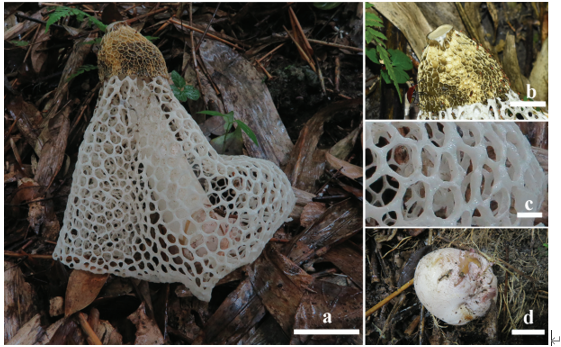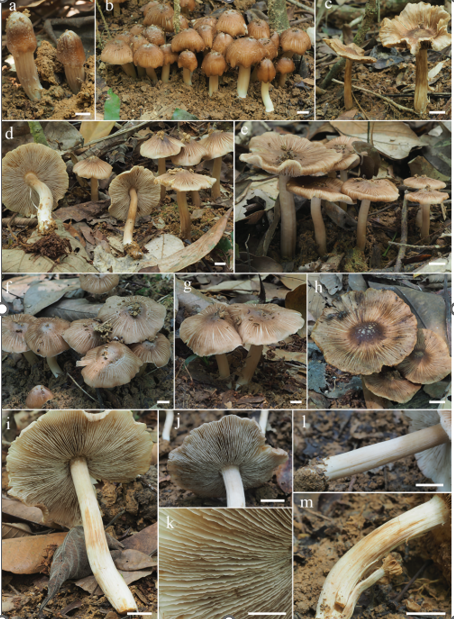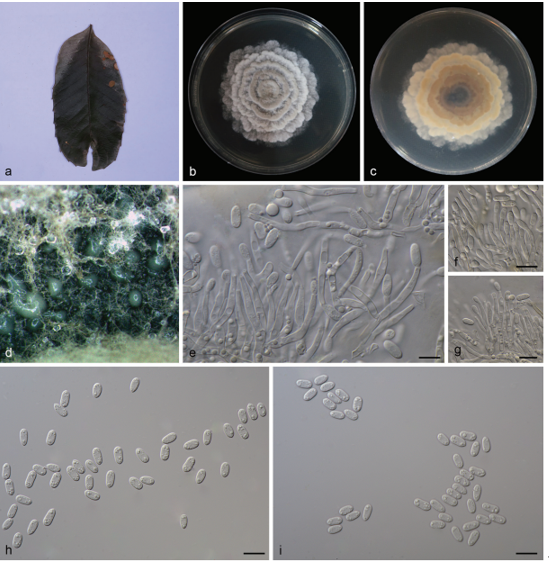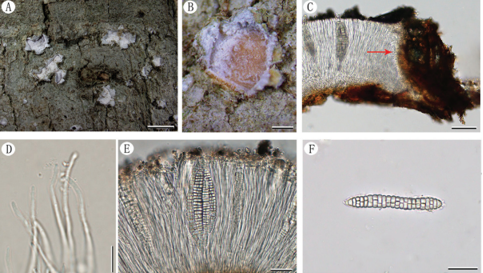Ophiostoma shanziensis Marinc., Z.W. de Beer, M.J. Wingf 2020
MycoBank MB835959
Holotype: China, Shanxi province, Guailingdi, from phloem adjacent to Dendroctonus valens gallery in Pinus tabuliformis, Jan. 2004, Q. Lu & C. Decock (holotype PREM 63070, culture ex-holotype MUCL 46456 = CMW 48329).
Morphological description
Asexual structures produced on pine twigs on the surface of water agar. Sexual morph not observed. Conidiophores mostly formed on aerial hyphal strings, single, grouped, conidiophores in range from micro- to macronematous and from mononematous to synnematous. Synnematous conidiophores: stipes flexuous, consisting of tightly compact hyphae, 162–1205 (583 ± 298) µm long, 6–34 (17.1 ± 5.77) µm wide near base, 5–39 (19.1 ± 7.93) µm wide before conidiogenous apparatus, individual hypha smooth, pale brown, uniformly pigmented; conidiogenous apparatus branched in 4–5 tiers, 54–377 (112 ± 65.4) µm long; conidiogenous cells hyaline, flexuous. Mononematous conidiophores in two types: 1) sporothrix-like; stipes upright, flexuous or straight, hyaline to subhyaline, occasionally branched, septate; conidiogenous cells blastic, hyaline, cylindrical, 7–66 (34.2 ± 15.56) µm long, 1–2(1.6 ± 0.34) µm wide near base, gradually tapering towards apex, 1–1.5 (1.2 ± 0.19) µm wide before fertile region, smooth,upper fertile region, 2–49 (16.7 ± 13.12) µm long, denticulate,showing sympodial growth; 2) leptographium-like, less common, possibly derivates of synnematous conidiophores; stipes flexuous or straight, upright hyaline to pale brown, occasionally branched, septate; conidiogenous apparatus branched; conidiogenous cells blastic, hyaline. Conidia in slimy heads or droplets, whitish or creamy with age, hyaline, ellipsoidal, slightly curved in side view, tapering to base, 3–4 × 1–2 µm (3.8 ± 0.26 × 1.5 ± 0.09 µm).
Culture characteristics — Colonies optimum growth at 25 °C(1.8 mm/d), followed by at 20 °C (1.4 mm/d), no growth shown at 35 °C, above and reverse colour umber to brown vinaceous inner circle with 5 mm margin of colourless to buff, showing flat, growing in circular mode with smooth margins. Mycelia mostly submerged with sparse fluffy aerial hyphae. Colony morphology similar at all temperatures.
Habitat: From phloem adjacent to Dendroctonus valens gallery in Pinus tabuliformis.
Distribution: In China.
GenBank Accession: βt: EU 502818 ;EF1-α: EU 502803;Act: n/a;ITS2-LSU: n/a; ITS1-ITS2: MT637221; Anon: n/a
Notes: This species was initially identified as Pesotum aureum (asexual morph of O. floccosum) by Lu et al. (2009b) and labelled as Ophiostoma sp. 3 by Taerum et al. (2013).However, additional isolates and analyses of sequences for a greater number of gene regions in the present study showed that the fungus resides in a distinct clade as a sister taxon to O. floccosum. Ophiostoma shanziensis did not produce a sexual morph in this study
Reference: S.Marincowitz1,T.A.Duong1, S.J. Taerum1,Z.W.de Beer1 et al.
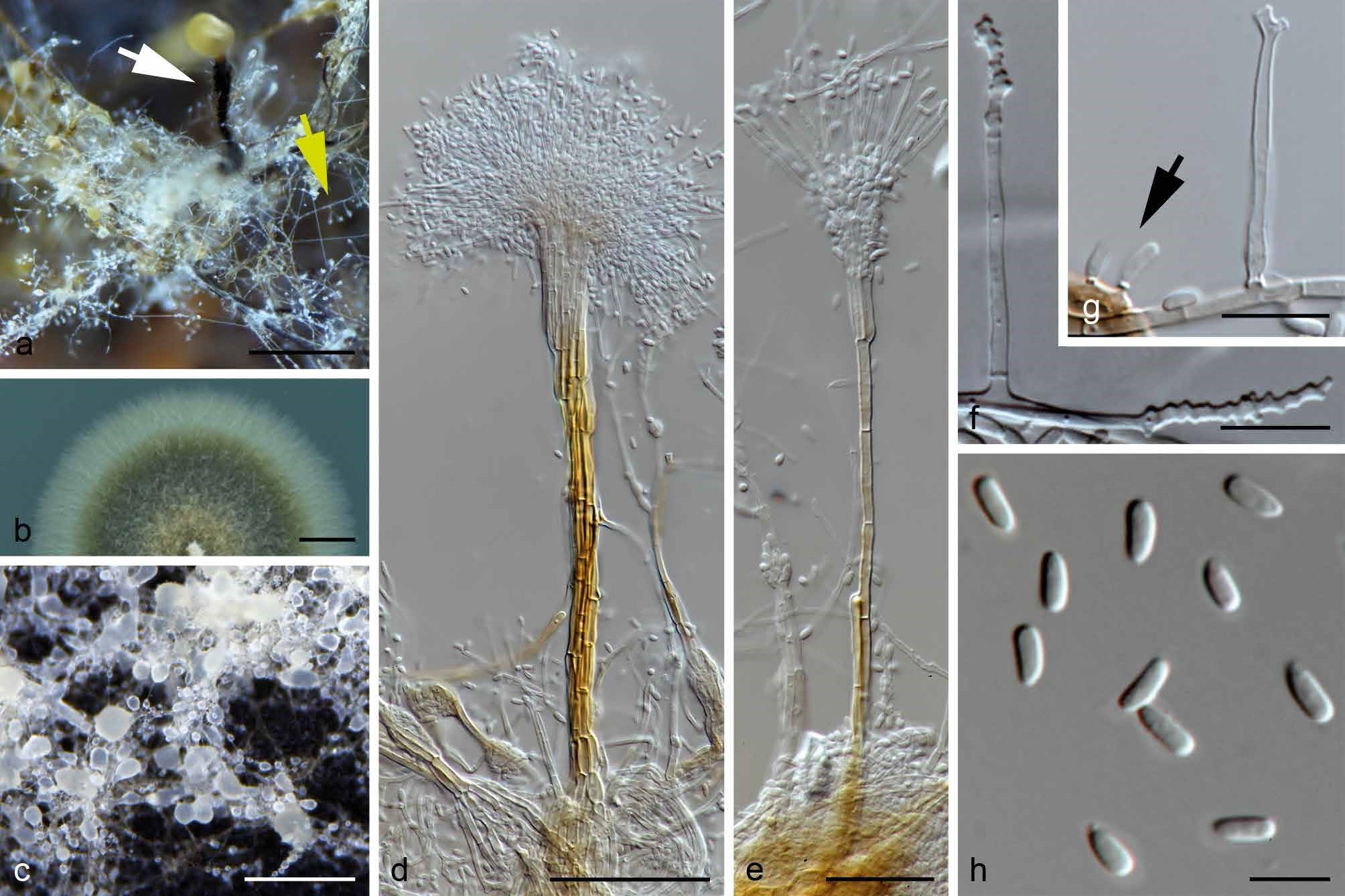
Morphological features of Ophiostoma shanziensis sp. nov. (ex-holotype, MUCL 46456 = CMW 48329). a. Synnematous (white arrow) and mononematous (yellow arrow) conidiophores produced on aerial hyphae on pine twig; b. colony on 2 % MEA at 25 °C for 7 d in the dark; c. conidial masses on MEA;d. synnematous conidiophore; e. mononematous conidiophores (rare), leptographium-like; f. mononematous conidiophores showing a stretch of denticles to which conidia was attached; g. conidiogenous cells and conidia directly borne on vegetative hyphae (arrow); h. conidia. — Scale bars: a = 500 µm; b = 5 mm;c = 250 µm; d = 50 µm; e = 25 µm; f–g = 10 µm; h = 5 µm


